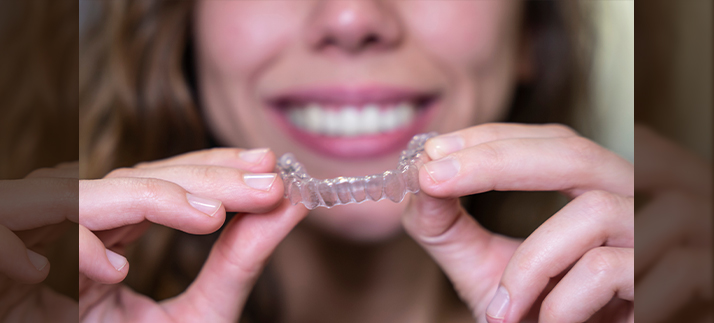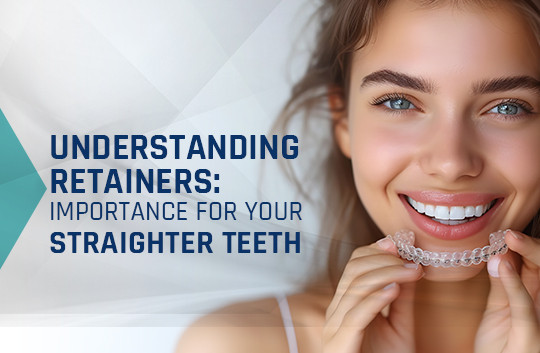

Understanding Retainers: Importance for Your Straighter Teeth
Are you considering straightening your crooked or misaligned teeth? If so, determining the most suitable method for your needs will be a significant part of the process. Whether you're considering innovative clear aligners such as Invisalign or traditional options like ceramic or metal braces, understanding the role of retainers is crucial. This blog post will guide you through the purpose of retainers in teeth straightening, explore the different types available, and explain why they are essential for maintaining your smile post-treatment.
What are retainers, and how do they function?
Opting for teeth straightening through traditional braces, clear aligners, or lingual braces alters the positioning of your teeth, necessitating a period for adjustment to their new alignment. Throughout the teeth-straightening process, while teeth gradually become straighter, the surrounding muscle tissues and ligaments also need time to adapt to the teeth's new, properly aligned positions.
Here, retainers play a crucial role. They are devices worn post-teeth-straightening treatment to maintain the teeth in their corrected alignment. Without a retainer, there's a risk of teeth reverting to their original positions. Retainers serve as a continuous reminder to keep teeth in their new placement.
Therefore, a retainer becomes an indispensable tool in your teeth-straightening journey, helping to secure a straighter smile for life.
Different Types of Retainers
Retainers are essential for maintaining teeth alignment after orthodontic treatment. They come in various forms, each with specific features:
Wire Retainers
Crafted from a mix of acrylic and wire, these fit behind the teeth. The acrylic molds to the palate, making wire retainers removable for oral hygiene and eating. These are versatile and durable solutions for a variety of storage and display needs. Wire retainers can be used in retail stores, garages, workshops, and even residential spaces for their practicality and ease of use. Some accessories such as hooks, baskets, and shelves can be attached to the panels, providing customizable storage solutions. Overall, they are an efficient storage and display option for various purposes.
Permanent Retainers
Also called fixed or bonded retainers, they comprise of a thin wire attached at the back part of your lower teeth. While less noticeable than other types, they require diligent hygiene due to their fixed nature and the potential for plaque buildup. These retainers are custom-made for each patient and are typically placed behind the lower front teeth or upper front teeth, where they are not visible during normal activities. They are designed to be discreet and comfortable, allowing for normal speech and eating. Though these retainers are effective at maintaining the teeth alignment, they require special care to keep them clean and prevent damage. Patients with permanent retainers are often advised to use floss threaders or interdental brushes to clean between the teeth and around the retainer. Regular dental check-ups are also important to monitor the condition of the retainer and ensure that it remains effective.
Clear Retainers
Made from transparent medical-grade plastic, clear retainers offer an inconspicuous option. They are custom-fitted for comfort and effectiveness. Vivera retainers, produced by the creators of Invisalign, provide a virtually invisible solution and are designed to resist wear from teeth grinding. Clear retainers are also easy to care and can be removed at the time of eating, drinking, and cleaning, which helps maintain good oral hygiene. It is important to follow the dentist's instructions for wearing and caring for clear retainers to ensure they remain effective. Overall, these retainers are a convenient and effective option for maintaining a straight smile after performing orthodontic treatment.
Each retainer type serves to keep teeth in place post-treatment, whether after traditional braces, Invisalign, or other methods.
Who needs a retainer, and why is it necessary?
Individuals who've undergone teeth alignment via braces are advised to use retainers. They represent the concluding stage of the orthodontic teeth straightening process, ensuring teeth stability in their corrected position. While some might assume orthodontic treatment ends with the removal of braces, wearing retainers as prescribed is crucial. Non-adherence to your orthodontist's recommendations can extend the treatment's duration unexpectedly. Regular use of a retainer necessitates ongoing visits to the orthodontist for adjustments, such as wire bending or trimming, to enhance comfort, underscoring the retainer's role in maintaining dental alignment post-treatment.
Is a retainer necessary after braces or Invisalign treatment?
Absolutely, wearing a retainer post-braces, Invisalign, or any chosen teeth-straightening method is essential. Without it, teeth risk shifting back to their original positions, potentially reversing the progress made. At the conclusion of your treatment, your orthodontist will provide a retainer, emphasizing its critical role in preserving your new smile.
How long is a retainer worn?
The duration varies by individual and should be discussed with your orthodontist. Typically, you may be advised to wear the retainer full-time for a set period, with exceptions for eating, drinking, brushing, and flossing.
Routine Orthodontist Check-ups
Ensuring regular follow-up visits with your orthodontist post-teeth straightening treatment is crucial. These appointments allow the orthodontist to assess the stability of your treatment outcomes, adjust as needed, and check the condition of your retainers. Additionally, they can advise on gradually reducing retainer usage.
Important Retainer Precautions
Adhering to your dentist's guidelines is crucial. Should issues arise with your retainer, contact your dentist promptly. To maximize retainer efficacy, observe these precautions:
- Follow the orthodontist's wear instructions for retainers.
- Avoid chewing gum with retainers in place and do not chew on the retainers.
- Handle retainers carefully when removing them from your mouth.
- Keep retainers in their designated case.
- Seek orthodontic advice if retainers cause discomfort.
Retainers play a critical role in maintaining the alignment of teeth after orthodontic treatment. Available as either fixed or removable devices, retainers are commonly used post-braces. Dentists recommend nightly wear for lifelong maintenance to prevent teeth from reverting to their original positions. Given the uniqueness of each treatment, consulting an orthodontist prior to starting any procedure is essential. Keeping retainers clean is vital for oral health. For teeth straightening with Invisalign or other methods, an orthodontist's guidance ensures successful treatment outcomes.
 70 Great Russell St, Holborn, London WC1B 3BN, UK
70 Great Russell St, Holborn, London WC1B 3BN, UK



























